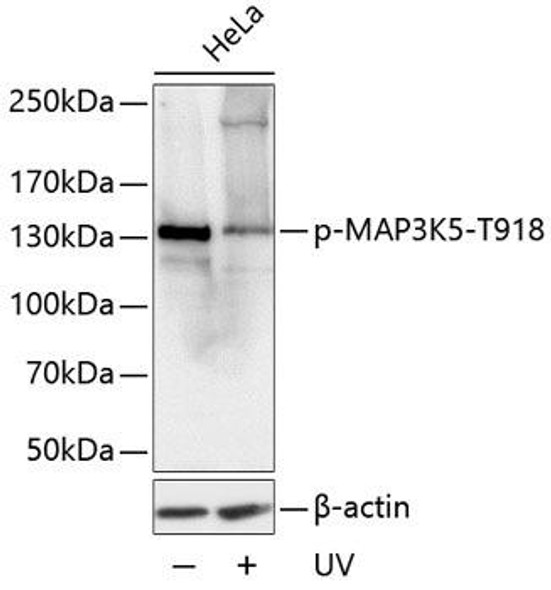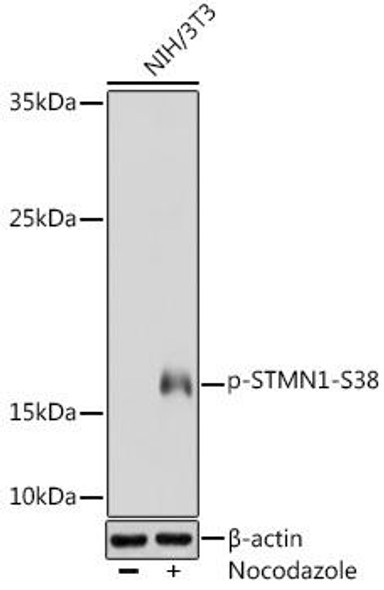Cell Biology Antibodies 16
Anti-Phospho-Ret-Y905 Antibody (CABP0600)
- SKU:
- CABP0600
- Product Type:
- Antibody
- Applications:
- WB
- Reactivity:
- Human
- Host Species:
- Rabbit
- Isotype:
- IgG
- Research Area:
- Cell Biology
Description
| Antibody Name: | Anti-Phospho-Ret-Y905 Antibody |
| Antibody SKU: | CABP0600 |
| Antibody Size: | 20uL, 50uL, 100uL |
| Application: | WB |
| Reactivity: | Human |
| Host Species: | Rabbit |
| Immunogen: | A synthetic phosphorylated peptide around Y905 of human Ret (NP_066124.1). |
| Application: | WB |
| Recommended Dilution: | WB 1:500 - 1:2000 |
| Reactivity: | Human |
| Positive Samples: | K-562 |
| Immunogen: | A synthetic phosphorylated peptide around Y905 of human Ret (NP_066124.1). |
| Purification Method: | Affinity purification |
| Storage Buffer: | Store at -20°C. Avoid freeze / thaw cycles. Buffer: PBS with 0.02% sodium azide, 50% glycerol, pH7.3. |
| Isotype: | IgG |
| Sequence: | DSYV K |
| Gene ID: | 5979 |
| Uniprot: | P07949 |
| Cellular Location: | Cell membrane, Endosome membrane, Single-pass type I membrane protein |
| Calculated MW: | 119kDa/124kDa |
| Observed MW: | 124kDa |
| Synonyms: | RET, CDHF12, CDHR16, HSCR1, MEN2A, MEN2B, MTC1, PTC, RET-ELE1, RET51 |
| Background: | This gene, a member of the cadherin superfamily, encodes one of the receptor tyrosine kinases, which are cell-surface molecules that transduce signals for cell growth and differentiation. This gene plays a crucial role in neural crest development, and it can undergo oncogenic activation in vivo and in vitro by cytogenetic rearrangement. Mutations in this gene are associated with the disorders multiple endocrine neoplasia, type IIA, multiple endocrine neoplasia, type IIB, Hirschsprung disease, and medullary thyroid carcinoma. Two transcript variants encoding different isoforms have been found for this gene. Additional transcript variants have been described but their biological validity has not been confirmed. |
| UniProt Protein Function: | Ret: a proto-oncogenic receptor tyrosine kinase. Receptor for glial cell line-derived neurotropic factor (GDNF) and its congeners neurturin, persephin and artemin. Part of a multicompetent receptor complex with other membrane-bound ligand-binding GDNF family receptors (aGFRs). Required for development of the kidney and neural crest-derived cell types. Three alternatively spliced isoforms have been described. |
| UniProt Protein Details: | Protein type:Protein kinase, TK; EC 2.7.10.1; Oncoprotein; Kinase, protein; Protein kinase, tyrosine (receptor); Membrane protein, integral; TK group; Ret family Chromosomal Location of Human Ortholog: 10q11.2 Cellular Component: cytoplasm; endosome membrane; integral to plasma membrane; intracellular membrane-bound organelle; plasma membrane; receptor complex Molecular Function:calcium ion binding; protein binding; protein-tyrosine kinase activity; Ras guanyl-nucleotide exchange factor activity; receptor activity Biological Process: MAPKKK cascade; membrane protein proteolysis; neuron adhesion; positive regulation of cell adhesion mediated by integrin; positive regulation of cell migration; positive regulation of transcription, DNA-dependent; posterior midgut development; protein amino acid phosphorylation; regulation of cell adhesion; response to pain; signal transduction Disease: Hirschsprung Disease, Susceptibility To, 1; Multiple Endocrine Neoplasia, Type Iia; Multiple Endocrine Neoplasia, Type Iib; Thyroid Carcinoma, Familial Medullary; Thyroid Carcinoma, Papillary |
| NCBI Summary: | This gene, a member of the cadherin superfamily, encodes one of the receptor tyrosine kinases, which are cell-surface molecules that transduce signals for cell growth and differentiation. This gene plays a crucial role in neural crest development, and it can undergo oncogenic activation in vivo and in vitro by cytogenetic rearrangement. Mutations in this gene are associated with the disorders multiple endocrine neoplasia, type IIA, multiple endocrine neoplasia, type IIB, Hirschsprung disease, and medullary thyroid carcinoma. Two transcript variants encoding different isoforms have been found for this gene. Additional transcript variants have been described but their biological validity has not been confirmed. [provided by RefSeq, Jul 2008] |
| UniProt Code: | P07949 |
| NCBI GenInfo Identifier: | 547807 |
| NCBI Gene ID: | 5979 |
| NCBI Accession: | P07949.3 |
| UniProt Secondary Accession: | P07949,Q15250, Q9BTB0, Q9H4A2, A8K6Z2, |
| UniProt Related Accession: | P07949 |
| Molecular Weight: | 119,847 Da |
| NCBI Full Name: | Proto-oncogene tyrosine-protein kinase receptor Ret |
| NCBI Synonym Full Names: | ret proto-oncogene |
| NCBI Official Symbol: | RET |
| NCBI Official Synonym Symbols: | PTC; MTC1; HSCR1; MEN2A; MEN2B; RET51; CDHF12; CDHR16; RET-ELE1 |
| NCBI Protein Information: | proto-oncogene tyrosine-protein kinase receptor Ret |
| UniProt Protein Name: | Proto-oncogene tyrosine-protein kinase receptor Ret |
| UniProt Synonym Protein Names: | Cadherin family member 12; Proto-oncogene c-Ret |
| Protein Family: | Retbindin |
| UniProt Gene Name: | RET |
| UniProt Entry Name: | RET_HUMAN |







